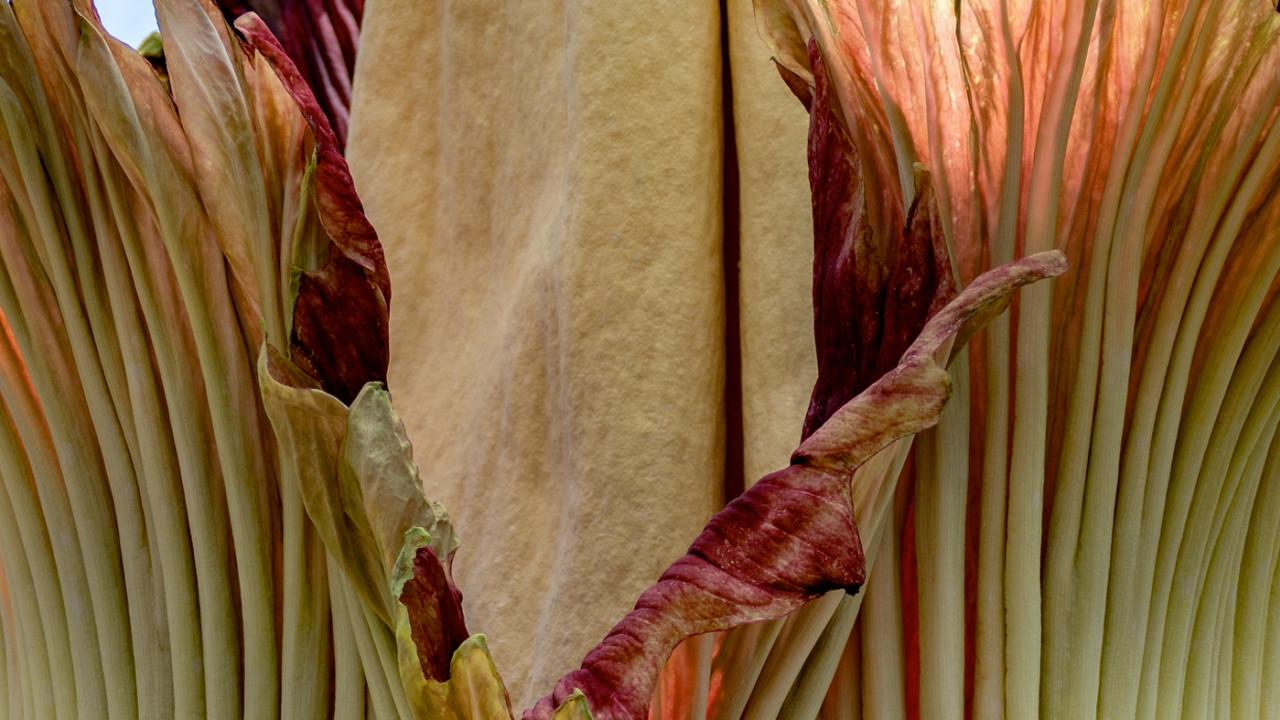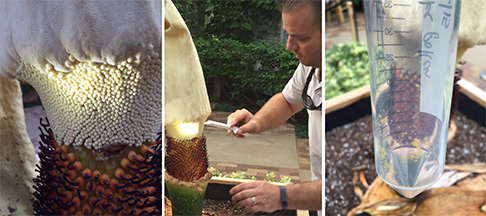
Spike the Titan Arum
We gathered pollen from Spike on September 3, 2015—see our blog post about pollen here. We are studying the structure of some of the pollen grains; the remainder has been banked to pollinate future titan arum blooms.
During August 2015, more than 75,000 people visited Spike, the Garden’s rare and unpredictable titan arum (Amorphophallus titanum). The plant piqued their interest and curiosity about the natural world and exotic plants. We are humbled and grateful to all who cheered Spike on, watching for bloom on the webcam, and visiting us daily. Spike thoroughly captivated and amazed our staff and all of you, our Garden friends.
On Monday, August 24, the plant reached its full height of 68 inches, and we expected to see its spathe open and unleash a terrible stench two to four days later. As any gardener knows, plants do not always behave as we would expect. We patiently waited for Spike to open, but the plant did not have the energy to do so by itself.

Read about the process in our blog post, Spike's Teachable Moment
Tim Pollak, outdoor floriculturist; Patrick Herendeen, Ph.D., senior director, Systematics and Evolutionary Biology; and Shannon Still, Ph.D., conservation scientist, removed the spathe instead, cutting around the base just above where it attached to the stalk of the plant. Once Spike reached complete dormancy, we replanted the corm.
Very little research exists about the titan arum. Native to the rainforests of western Sumatra, Indonesia, the titan arum rarely blooms. Garden conservation scientists are currently studying Spike's pollen and continue looking into the bloom's arrested development. The Garden will make this information available to other botanic gardens and conservation groups interested in learning more about the titan arum.
Q & A
Did Spike ever smell?
If you put your nose up to the bloom, there was a very slight scent.
Why do we think Spike didn't bloom?
We’re not entirely sure. In nature, plants have the choice of reproducing or surviving. Spike “chose” to survive, having run out of energy to complete reproduction.
Did our scientists diagnose why the plant didn't bloom by opening it? If not, is someone going to study this?
No, opening the bloom did not give us an answer to the “why” question. We did collect pollen from the male flowers.
Were we able to pollinate Spike?
Spike's female flowers did not fully develop, so we were unable to pollinate them.
What are the benefits of pollinating?
Among the benefits of pollination are increasing genetic diversity and sharing seed with other botanic gardens.
Is it harmful to the plant when you open it up?
No. This is pretty standard when the plants are being pollinated (but not on public display). Cutting off the spathe is a common protocol for collecting pollen from an Amorphophallus. This is typically not done to the titan arum due to the rarity and beauty of the bloom. This should not hurt the corm but definitely detracts from the visual display.
Did fruit appear on the plant?
No. No fruit can develop unless the female flowers on the plant are pollinated. We were unable to pollinate Spike. The female flowers did not appear ready for fertilization; the male flowers released a very small amount of pollen.
What did we do with Spike?
Spike has been moved back to the Production Greenhouse.
Growth Chart
| Date: | Height: |
| 8/29/15 | 68" |
| 8/28/15 | 68" |
| 8/27/15 | 68" |
| 8/26/15 | 68" |
| 8/25/15 | 68" |
| 8/24/15 | 68" |
| 8/23/15 | 67.75" |
| 8/22/15 | 67.5" |
| 8/21/15 | 66" |
| 8/20/15 | 65.25" |
| 8/19/15 | 63.0" |
| 8/18/15 | 61.25" |
| 8/17/15 | 58.75" |
| 8/16/15 | 54.5" |
| 8/15/15 | 51.25" |
| 8/14/15 | 47.0" |
| 8/13/15 | 41.0" |
| 8/12/15 | 39.5" |
| 8/11/15 | 38.0" |
| 8/10/15 | 36.25" |
| 8/9/15 | 33.0" |
| 8/8/15 | 31.0" |
| 8/7/15 | 29.25" |
| 8/6/15 3 p.m. | 28.0" |
| 8/5/15 | 25.0" |
| 8/4/15 | 23.5" |
| 8/3/15 | 22.75" |
| 7/31/15 | 21.0" |
| 7/30/15 | 20.25" |
| 7/29/15 | 19.25" |

